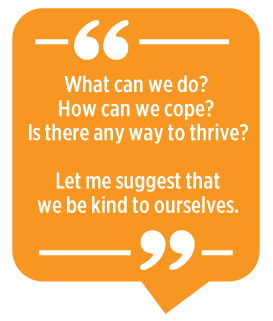From the President: Taking Care
by Deborah J. Short
 When the
world shut down in March because of COVID-19, we all expected to be back to
normal by September, didn’t we? For some of you, that reality is close. You may
be more cautious in your social or workplace face-to-face interactions, but you
are no longer sheltering at home or avoiding trips to the store, the doctor, or
your favorite restaurant. But many are not yet back to normal, although none of
us want this state of affairs to turn into a new normal.
When the
world shut down in March because of COVID-19, we all expected to be back to
normal by September, didn’t we? For some of you, that reality is close. You may
be more cautious in your social or workplace face-to-face interactions, but you
are no longer sheltering at home or avoiding trips to the store, the doctor, or
your favorite restaurant. But many are not yet back to normal, although none of
us want this state of affairs to turn into a new normal.
An analogy
for the United States, Brazil, India, and other countries where coronavirus
cases are rising might be this: The light at the end of the tunnel is not the
exit but an oncoming train. We continue to not know what to expect. The danger
isn’t gone. We can’t fix our economy without getting a grip on the virus. We
can’t fix our schools without getting a grip on the virus. We can’t travel to
visit our loved ones without getting a grip on the virus.
What can we
do? How can we cope? Is there any way to thrive? Let me suggest that we be kind
to ourselves. That we take care of ourselves.
We are
weathering the COVID-19 storm; we are learning how to help ourselves, our
colleagues, and our English learners every day. I’m sure you have been busy
these past few months exploring better ways to teach remotely and figuring out
how to go back to face-to-face instruction safely, if only for part of an
academic week. You’ve been redesigning your curriculum and revising your
assessments for an online world.
 Educators
are essential workers. You are an essential worker. Our students and their
parents rely on us. They expect us to be present, ever striving to instill
knowledge. But just like we tell new teachers “chunk and chew”—teach for 10
minutes and let students process for two—we need regular breaks to refresh and
regroup as well.
Educators
are essential workers. You are an essential worker. Our students and their
parents rely on us. They expect us to be present, ever striving to instill
knowledge. But just like we tell new teachers “chunk and chew”—teach for 10
minutes and let students process for two—we need regular breaks to refresh and
regroup as well.
I thought I
would do a lot of pleasure reading after things shut down in March. Ha! I
couldn’t escape into fantasy or historical fiction. The real world was already
a dystopian, surreal environment. I was reading daily, yes, but it was news
reports and technical guidelines for apps like Zoom. I was staring at a screen
for hours and hours each day and couldn’t stare at a book at the end of an
evening. I was tense, worried, unsure.
Recently,
though, I made the decision to carve out time each day for non-work-related
reading. I just finished a book, Painting
Harlem Modern: The Art of Jacob Lawrence by Patricia
Hills. I had the book prepandemic, but it lay on my living room table for
months. I finally picked it up last week and found joy. No—really. Gazing at
Jacob Lawrence’s vibrant paintings let me imagine I was in a museum, following
his narrative path in the Toussaint L’Ouverture, the Harriet Tubman, the Great
Migration, and the life in Harlem series, among his other works of art. And
while the social commentary of his paintings is pertinent to today’s time and
troubles, the strength and universality of his images was rejuvenating and
engaging.
For many of
us, the academic year is starting. It’s busy, it’s stressful, it’s unknown.
There’s hardly time to take a breath. But do so, for yourself and your
students. Take time for self-care. Find an activity to enjoy. Find a friend to
share the experience with, even if it is a recounting done from a distance.
Exercise, dance, sing, write, sew, sketch, or cook. Find moments of
peace.
Deborah J. Short, PhD, is TESOL International Association president (2020–2021). She directs Academic Language Research & Training, LLC and provides professional development on academic literacy, content-based ESL, and sheltered instruction worldwide. She has led numerous research projects related to English learner education, codeveloped the SIOP Model, and served as series editor for several 6 Principles books.
TESOL Blogs
Interested in writing a blog for TESOL?
Read the submission guidelines and send us your post!
Check out some of the most recent TESOL Blogs:
|
3 Speaking Skills for the First Day of Class: Hit the Ground Running, by A. C. Kemp

For many of us, the first day of school is fast approaching. The first class is crucial because it sets the tone for the rest of the semester. Therefore, we focus on creating a friendly, low-stress environment, setting clear expectations, and building community through introduction activities.
One thing we don’t always do is teach new skills on the first day. However, doing so can add another dimension to the class and give students a feeling of accomplishment right off the bat.
Following are three examples of how speaking skills can be built into introduction activities that you may already be doing: The Name Game (vocabulary), Twist and Shout (tag questions), and In Common (question intonation). Read more. |
|
7 Virtual and Face-to-Face Activities for the First Week of School, by Judie Haynes

As we go back to school this fall, many teachers are faced with changing school policies because of the COVID-19 pandemic. School districts that originally planned to go back full time to their brick-and-mortar buildings may have to change their plans at the last minute depending on the COVID-19 statistics in their state. Many teachers are planning for both face-to-face and virtual classrooms because their districts are implementing a hybrid model.
I think teaching during a pandemic is the biggest challenge modern teachers have ever faced. Many teachers will be meeting their students for the first time in a virtual classroom. Getting to know students is a necessary step for all teachers in setting up a safe and caring environment, whether it is virtual or face-to-face. Read more. |
|
Making Discussion Boards More Engaging, by Betsy Gilliland
 With the world’s education systems shifting to online instruction as the COVID-19 pandemic continues into a new academic year, teachers need to think carefully about how we can maintain the interactive features we value in face-to-face classes without endangering our students’ health. Most learning management systems (LMSs) have some form of discussion board tool that allows students to post something they have written and reply to their classmates’ posts. Depending on the LMS, these may be simple text boxes where students can only write words, or they may have more functionality and allow students to share links and images as well. With the world’s education systems shifting to online instruction as the COVID-19 pandemic continues into a new academic year, teachers need to think carefully about how we can maintain the interactive features we value in face-to-face classes without endangering our students’ health. Most learning management systems (LMSs) have some form of discussion board tool that allows students to post something they have written and reply to their classmates’ posts. Depending on the LMS, these may be simple text boxes where students can only write words, or they may have more functionality and allow students to share links and images as well.
Discussion boards are useful because they make it possible to have asynchronous interaction in an online format. Students can work on their own time but also see their classmates’ ideas and collaborate. With social distancing required in classrooms, this format can be more personal than sitting 6 feet away and shouting through masks during an attempt at face-to-face discussion. Students can also make use of internet resources to support their writing. Read more. |